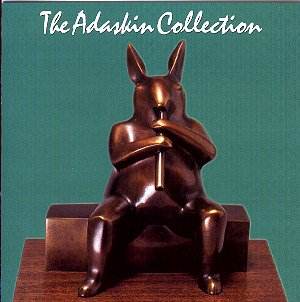Murray Adaskin was born in Toronto in 1906, and has
for much of his life been an important influence in Canadian music.
His own music is highly personal and beautifully crafted, with a manifest
understanding of the instruments and ensembles for which it is written.
The idiom – no surprise given Adaskin’s date of birth – is firmly mid-century,
and influences include Hindemith, Prokofiev and Milhaud, this last being
among his teachers.
We have two wind pieces at either end of the disc,
enclosing two string works. The two Woodwind Quintets, separated by
some nineteen years, are basically very similar, both consisting of
three movements, the first two of which are comparatively extended,
followed by a very brief finale. As befits the medium, the character
of the music is quite light, divertimento-like, though the second quintet
sets out in more solemn vein. Adaskin has a real feel for wind instruments,
and understands that, when writing for this particular combination,
blend is at a premium, and the composer must capitalise on the contrasting
characteristics of the five instruments. He does this well, resulting
in lively entertainment for both audience and players. The Bergen Quintet
play well, with secure ensemble, crisp rhythm, and excellent intonation,
though they’re not helped by a boxy recorded sound. On the other hand,
the engineers have got the internal balance of the quintet right,
which is something very much to be thankful for.
Musica Victoria was written for the group that
performs it here, the Thüringer Salonquintett, two violins, ‘cello,
double bass and piano. They specialise, the notes tell us, in central
European light-entertainment music – waltzes and the like, some film
music, and light classical music. So whether this thoughtful and slightly
gloomy piece was what they were wanting is hard to say, though no doubt
they were familiar with Adaskin’s style and knew something of what to
expect. They give it a sympathetic, carefully prepared reading, while
the composer has used the resources of the group well, exploiting the
dark tones of the double bass particularly effectively.
The programme (rather short it has to be said) is completed
by the Sonatine Baroque for unaccompanied violin. This is Adaskin
composing for his own instrument, and the writing is superbly idiomatic.
The angular first movement is followed by an Adagio of simple
and affecting lyricism, forthrightly tonal in contrast to the first
movement’s gritty bitonality. The final movement is a good-natured Allegro,
with an expressive Allegretto as its central section.
Jack Glatzer gives this absorbing and rather beautiful piece an imaginative
and flexible performance.
Despite the limitations of the recording, I enjoyed
the music on this disc greatly. It is engaging and full of personality,
and the performances are good enough to do it ample justice.
Gwyn Parry-Jones
CONTACT
Canadian Music Centre
20 St Joseph St
Toronto, OntarionM M4Y 1J9
http://www.musiccentre.ca/CMC/dac_rca/BiosSet.html
also available at
AdLar Publications
3020 Devon Road
Victoria, BC
Canada V8R 6C9
adaskin@print.ca


